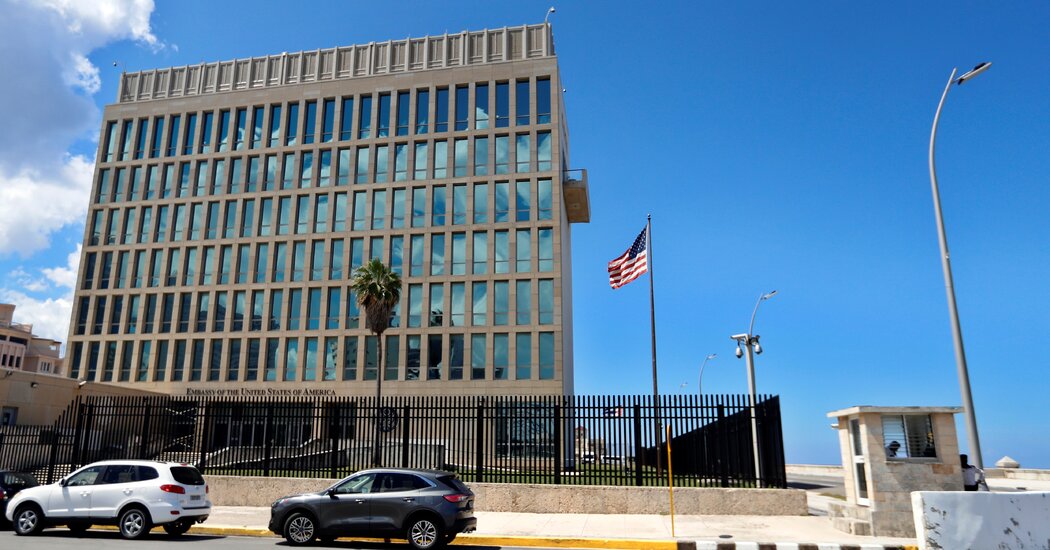The tool, essentially a standardized battery of questions and medical tests, can help determine the kind of care needed by people affected by the “anomalous health incidents.”
WASHINGTON — The Biden administration is refining a screening tool it developed last year to evaluate the symptoms and injuries of people who experienced the so-called Havana syndrome, as it continues to search for a cause and prepares to compensate federal officials who have been affected.
The next version of the tool — essentially a medical exam with a standardized battery of questions and tests — is likely to include a new section focusing on anxiety and depression. The addition comes as more people have reported psychological symptoms, according to a State Department official familiar with the planning. The officials interviewed for this article spoke on the condition of anonymity to discuss elements of the inquiry into the causes of Havana syndrome.
The tool cannot diagnose someone experiencing Havana syndrome, federal officials said, but it can help determine what kind of care the person needs. Although the administration has been trying to improve the tool, it will not be used to determine who qualifies for compensation under the Havana Act, a new law that will provide financial support for affected C.I.A. officers, State Department diplomats and other federal officials.
The “anomalous health incidents,” as the government calls them, started in 2016, when C.I.A. officers and diplomats serving in Havana reported strange sounds and other sensations, then experienced headaches, nausea and dizziness. Since then, U.S. officials around the world have reported similar episodes, with large numbers of cases in Vienna and several locations in China.
There have been some 750 reports of possible episodes from current and former government workers. The C.I.A. team searching for a cause has focused on about 200 of them.
Five years after the first cases were identified, no single medical test can determine whether someone has Havana syndrome or is experiencing a different ailment with similar symptoms. Investigators have yet to determine what causes the syndrome, although officials said that directed energy, possibly microwaves, remains a leading theory.
The most recent version of the exam takes about two and a half hours and aims to assess the neurological, cognitive, ocular, auditory and vestibular function of people who suspect they have the mysterious ailment.
In general, the government will categorize a case as probable Havana syndrome if the patient reports an initial sensory experience like heat, pressure or sound, followed by symptoms such as nausea, intense headache, ringing in the ears or persistent vertigo. Investigators try to rule out pre-existing health problems or environmental factors. The screening tool administers eye-movement tests to gauge overall coordination, hand-eye coordination and balance, according to administration officials.
Administration officials have found consistencies across many cases as more have been evaluated, helping them refine the tool. At the same time, they have been able to narrow the criteria, eliminating some cases because the patients did not experience initial sensations of heat, pressure or unusual sounds followed by headache, nausea or other symptoms. The tool is “very fluid, changing as we go,” one official said.
Marc Polymeropoulos, a retired C.I.A. officer who started experiencing symptoms of Havana syndrome in Moscow in 2017, said that the government agencies that screen people with symptoms — including the Defense Department, the State Department and the C.I.A. — needed a consistent method of doing so. The tool, he said, could also help focus investigative efforts on the cases that are most likely related to Havana syndrome.
“You need to move from a piecemeal to a whole-of-government approach,” he said. “They needed to consolidate all the reporting mechanisms of the different agencies.”
Early last year, the Biden administration and the C.I.A. began an intense hunt for what could be causing the injuries. So far, that effort has not turned up any evidence pointing to a source. But some administration officials insist that the injuries are real, and that they will continue to look for a cause.
The Biden administration has until April to draft rules for awarding compensation; the State Department and the C.I.A. are working on separate sets of rules. Once they are finished, the law requires the administration to brief Congress. A State Department official said the screening tool was central to evaluating people with symptoms but was not a diagnostic tool. As a result, the official said, it cannot be used for determining compensation.
The Havana Syndrome Mystery
What is the Havana Syndrome? The mysterious illness, which has affected military officers, C.I.A. personnel and diplomats around the world, manifests itself in a host of ailments such as chronic headache, vertigo and nausea.
While the law is intended to compensate patients for injuries related to Havana syndrome, it also provides assistance for a variety of government service-related injuries. Under the legislation, a C.I.A. officer who incurred a brain injury while serving in Iraq or Afghanistan could qualify for additional compensation.
Intelligence agencies have not used the screening tool to categorize incident reports. Still, government officials and medical providers said the tool was helping them learn more about the symptoms associated with Havana syndrome and the injuries people were experiencing. It has helped people get care, the officials said, even if they have not met the criteria for a Havana syndrome case.
Dr. Pablo A. Celnik, the director of the department of physical medicine and rehabilitation at Johns Hopkins Medicine, said the program he oversees has treated a few dozen patients who were referred to the hospital after being screened by the triage tool. So far, he said, only a few ended up having diagnosable illnesses.
“Most of the time, we don’t find anything very clear-cut that can explain all of the symptoms,” Dr. Celnik said.
He said patients referred to Johns Hopkins by the State Department have an array of symptoms, like confusion, forgetfulness, trouble focusing, headaches, balance issues, hearing a ringing or buzzing sound, and pain on one side of the face. Some also experience anxiety or depression. But those symptoms are common in patients newly diagnosed with an illness, he said, and may not be directly attributable to the anomalous health episodes.
Dr. Celnik said that once patients who have been screened with the tool arrive at Hopkins, medical providers there focus on treating the symptoms rather than finding a concrete diagnosis.
“When the patients come, the first thing we try to do is rule out other medical conditions,” he said. “Once we have ruled out that there aren’t other possible diagnoses that are causing this, we engage right away in rehabilitation and recovery.”












